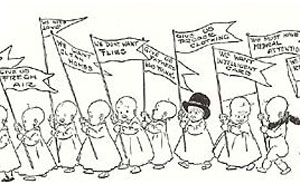talking history | syllabi | students | teachers | puzzle | about us
Adoption History Project
http://darkwing.uoregon.edu/~adoption/
Created and maintained by Ellen Herman, University of Oregon.
Designed by the Wired Humanities Project.
Reviewed June 12–13, 2007.
Adoption history is an interesting field. It has a lot of audiences, only some of them scholarly, who care passionately about it. Adoptees, social workers, adopters, and potential adopters all turn up for academic lectures on the history of adoption. While it is exciting to feel historical scholarship so tangibly useful, it also makes the work a little fraught. These audiences will argue vigorously with you if they do not like the implications of your conclusions, and it is not always clear that there is agreement on the criteria for “truth” (a few years ago at the Organization of American Historians conference, a nonacademic adoptive parent got into a passionate dispute with a historian about whether the annual number of adoptions in the United States has declined in recent decades). It is also a new field, so there are few established secondary works that set the parameters of our knowledge or determine what the questions are. The Adoption History Project Web site is a helpful entrant into this contested field, public intellectual work at its best; it is Web-based, as many adoption-related communities are, and offers smart, original scholarship that renders transparent how historians work.

Cartoons for Baby Week, sponsored by the U.S. Children’s Bureau, appeared in many newspapers.
This one depicted children asking for love, intelligent care, protective laws, birth registration,
and “fathers who think” among other things.
The heart of the site is a set of short (200–800-word) articles on fifteen individuals/organizations and on thirty-five topics in adoption in the twentieth century, ranging from traditionally scholarly ones such as “eugenics,” to agonized, intimate ones such as “telling” (children that they are adopted). The articles do not shy away from controversial questions—transracial placement, questions of “quality” in adoption, open adoption. They do what historians can so usefully do in public debates: historicize the controversies, suggesting something about how they have changed over time and to what other issues they have been linked. At the end of each short piece are links to primary documents—few of which have been cited by historians before, the fruits of Ellen Herman’s archival research. The primary sources are more than a useful supplement to the text; they are its footnotes and clearly demonstrate the origins of the historical arguments. Although it is not designed as a teaching site, it offers such a clear account of historical work that I have used it to teach primary research to undergraduate and beginning graduate students. It is also an excellent archive—exemplary rather than exhaustive, but surprisingly comprehensive in its subjects and range across the twentieth century.
The site also includes a timeline, a bibliography, and excerpts from that staple of adoption discourse, the “outcome study,” decades worth of efforts by psychologists and sociologists to assess whether adoption produces pathological adults and/or new social formations. The timeline puts the information in the articles in chronological order (with hyperlinks to the articles), showing the development of adoption policies in the United States. The bibliography, although it makes no pretense of completeness, is excellent.
The site is a perfect hybrid of everything a good Web site should be—visually pleasing, graphically good, artistically laid out, easy to navigate—and everything a good piece of historical work should be—original, archive driven, well written, and revealing of the significance of change over time. As a result, the site has been a sturdy resource for its multiple audiences—it is linked from Web sites advertising the services of adoption facilitators, is cited and used by historians, and has been a resource to the media.
Laura Briggs
University of Arizona
Tucson, Arizona
